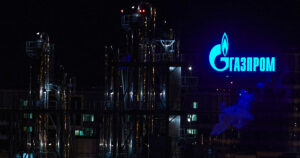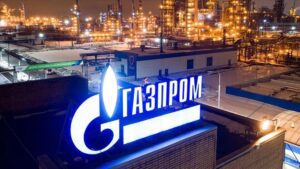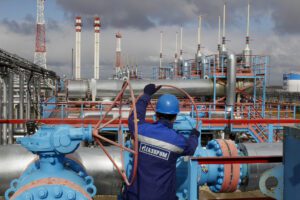
The DTEK energy holding company in the Netherlands has secured the seizure of assets belonging to Gazprom International Limited, a company controlled by the Russian Federation, in the form of a 50% stake in the Dutch company Wintershall Noordzee B.V., as part of the enforcement of an arbitration award.
“Gazprom International Limited appealed the seizure, but the District Court of The Hague rejected Gazprom International Limited’s appeal and upheld the seizure,” DTEK told Interfax-Ukraine news agency.
The company recalled that after the illegal occupation of Crimea in 2014, Russia also illegally seized and expropriated all assets of the energy distribution company DTEK Krymenergo, which distributed and supplied electricity in Crimea.
In 2017, DTEK Krymenergo filed a lawsuit with the International Court of Arbitration in The Hague, demanding that Russia pay damages caused by the illegal expropriation. In 2023, the international arbitration court in The Hague upheld DTEK’s claim and awarded damages of approximately $267 million from the Russian Federation, including interest, which will accrue until full payment is received.
“Since Russia did not comply with the international court’s decision and did not pay the damages awarded, DTEK initiated enforcement proceedings to recover damages from Russia in countries where Russian assets are located,” the energy holding company said.
Currently, active enforcement procedures and measures against Russia are being carried out in the United States, the United Kingdom, the Netherlands, the Czech Republic, and Israel. In addition, measures are being developed for enforcement in other jurisdictions.
As reported, in the fall of 2023, the International Court of Justice in The Hague fully upheld DTEK’s claim against Russia regarding seized assets in the illegally annexed Crimea and ordered Russia to pay the Ukrainian company compensation in the amount of $267 million. The arbitration award is enforceable under the 1958 New York Convention.
At the same time, the energy holding company noted that it plans to immediately initiate the process of recognition and enforcement of the award in the territories of those states where Russia has assets.
DTEK Krymenergo was the largest electricity supplier on the Crimean peninsula, providing more than 80% of its supply.
Wintershall Noordzee B.V. is engaged in the exploration and production of natural gas in the North Sea on the continental shelf of the Netherlands and the United Kingdom. Wintershall Noordzee B.V. is a subsidiary of the German company Wintershall Dea.

Naftogaz Group is already sending a payment request to Gazprom to recover $1.37 billion in accordance with the Final Award of the international arbitration in Zurich received by the company on June 20, 2025.
“If Gazprom refuses to comply with the decision voluntarily, Naftogaz will start implementing a strategy for the enforcement of the Russian company’s assets,” the company said in a press release on Tuesday.
As explained by the group, the amount of $1.37 includes the principal debt for gas transit services under the 2019 agreement, as well as penalties and compensation for all legal costs incurred by Naftogaz.
At the same time, the Group continues to enforce another arbitral award – on payment of $5 billion in compensation to the Russian Federation for the illegal expropriation of assets in Crimea in 2014.
“The enforcement process is ongoing at various stages in ten jurisdictions. In Finland and France, there are already first results – Russian property has been seized. In other countries, the work continues,” Naftogaz said.
For reasons of legal strategy, the company is not disclosing additional details at this time.
In most jurisdictions, the interests of Naftogaz are represented by leading local law firms free of charge, on a pro bono basis.
As reported with reference to Naftogaz CEO Serhiy Koretsky, the international arbitration tribunal, which considered in Switzerland the case of Gazprom’s violation of its contractual obligations on the take-or-pay principle, ordered the Russian corporation to pay $1.37 billion in favor of Naftogaz of Ukraine.
“In September 2022, Naftogaz initiated arbitration, which Gazprom tried to block through Russian courts. This did not work. Now we have the final decision: the tribunal of arbitrators from Sweden, Switzerland and Israel completely sided with Naftogaz,” Koretsky wrote on his Facebook page on Monday evening.
He reminded that Gazprom had violated its contractual obligations under the take-or-pay principle since May 2022 by stopping payments.

Gazprom’s bid for gas transit through Ukraine has increased to the maximum for the last month (since January 15).
“The operator of Ukraine’s gas transmission system (OGTSU) said it had accepted a transit request from Gazprom for Wednesday in the amount of 35.8 million cubic meters. The figure on Tuesday was 30.8 million cubic meters. The capacity is claimed for only one of the two entry points into the country’s GTS, the Suja gas metering station. No application has been accepted for the corridor through the Sohranovka gas metering station.
The current level of gas reserves in Europe has fallen to 65.66 percent, 20 percentage points above the average for the same date in the last five years, according to the Gas Infrastructure Europe (GIE) association. During the Feb. 13 gas day, inventories were down 0.45 percentage points.
Warm weather in October, November and January as well as austerity measures have resulted in UGS reserve levels now at their highest ever recorded. This strengthens confidence of the authorities in the successful passing of the winter.
Europe’s LNG receiving terminals operated at 62 percent capacity in January, nearly the same in the first days of February. At the same time the level of LNG inventories in the tanks of receiving terminals is decreasing more and more. This suggests that the inflow of new LNG cargoes to the region is falling amid low prices and competition from Asia.
The day-ahead contract at the TTF hub in the Netherlands added just over a percent in the past 24 hours, closing at $592 per thousand cubic meters.
The “Asian premium” is stable. – gap between gas prices in Asia and the price of LNG supplies to Europe. March futures for JKM Platts (Japan Korea Marker, reflecting the spot market price for cargoes supplied to Japan, South Korea, China and Taiwan) traded at $639; futures for LNG supplied to North West Europe (LNG North West Europe Marker) traded at $582.
The state of U.S. UGS reserves is becoming increasingly important to the global market as the country is actively ramping up exports.
In the regular reporting week (ended Feb. 3), reserves fell by 6.1 bcm. For the first time since the beginning of the year, weekly withdrawals exceeded the average for the last five years.
The current reserve level is 49%, 5 percentage points above the five-year average, according to the U.S. Department of Energy’s Energy Information Administration (EIA).
February promises to be a cold month in the country, which will lead to an increase in energy spending for heating. On the other hand – America’s largest LNG plant, Freeport LNG, is still delaying its restart after an accident, leaving gas that was supposed to go to exports in the domestic market.
So far, the EIA has projected that storage inventories will fall by 60 billion cubic meters this winter (the average for the last five years). At the end of March, natural gas volumes in storage are projected to be 40 billion cubic meters. This is 8% below the five-year average.

The Gas Transmission System Operator of Ukraine, or GTSOU, has accepted a booking from Gazprom today to transport 42.4 million cubic meters of gas through the country against 42.4 mcm the previous gas day, data from GTSOU show.
Capacity was requested only through one of two entry points into Ukraine’s Gas Transmission System, the Sudzha metering station. A request was not accepted through the Sokhranivka metering station.
GTSOU has declared a force majeure about accepting gas for transit through Sokhranivka, claiming that it cannot control the Novopskov compressor station. Ukraine has also said that if gas continued to be fed from Russia to the Sokhranivka station, amounts would be reduced accordingly at the exit points from Ukraine’s gas transport system. The route through Sokhranivka had provided transit of more than 30 mcm of gas per day.
Gazprom believes there are no grounds for the force majeure or obstacles to continuing operations as before.
Electricity generated from wind power in Europe has dropped nearly 50% in the past two days, and the forecast for Thursday and Friday calls for practically calm weather, which requires utilizing other sources of energy.
Europe’s current temperatures are reaching all-time lows for the month of September, and could be the coldest for the past nine years at more than two degrees below last year’s figure. The forecast in Europe until the end of the month is light winds or calm weather.
Another cold spell has begun in Europe, and it should last at least a couple of days.
Electricity generated from wind power has dropped for the second consecutive day. Wind turbines generated 22.8% of the European Union’s energy balance on Monday, falling to 13.6% on Wednesday. Meantime, the figure is only 6.8% in Germany and 3.3% in the Netherlands, according to data from the WindEurope association. The average for September 2021 was 9.6%.
Spot prices for gas in Europe have risen sharply since Gazprom announced that Naftogaz Ukraine’s latest lawsuit could disrupt transit through Ukraine, adjusting to $2,005 per 1,000 cubic meters for the TTF day-ahead contract.
Prices in Asia are rising on the back of prices in Europe. The most expensive January futures on the JKM Platts index, which reflects spot market prices for gas delivered to Japan, South Korea, China and Taiwan, are $1,962 per 1,000 cubic meters.
The Nord Stream pipeline from Russia to Europe has been unable to restart as planned after maintenance, as oil leaks were found in Siemens turbines and this problem can only be fixed with factory repairs, Gazprom said. The Siemens turbines can only be repaired at a plant in Montreal, but Canada has imposed sanctions against the Russian gas giant.
Moreover, there were reports on Monday of a drop in gas pressure in two strings of Nord Stream 1 and in one string of Nord Stream 2 near the Danish island of Bornholm.
European liquefied natural gas (LNG) receiving terminals are operating at an average of 59% of capacity in September compared to 59% in August, data from Gas Infrastructure Europe indicate, and gas has been received from the EemsEnergy LNG floating receiving regasification terminal since September 16 in the Netherlands.
Europe is continuing to inject gas into underground gas storage (UGS) facilities, with the average level of reserves reaching the targeted 80% of capacity at the end of August. After reaching the target level, there has been some reduction in the injection rate.
Inventories in UGS facilities are currently at 88.17%, up just 0.2 percentage points from the last reporting date, according to Gas Infrastructure Europe data.
Gas inventories in UGS facilities have currently exceeded 80% in Belgium, the Czech Republic, Croatia, Denmark, France, Germany, Italy, the Netherlands, Poland, Portugal, and Spain.
Meanwhile, Austria, Bulgaria, Hungary, and Latvia are lagging, with Austria showing a clear trend toward reaching the target level of reserves by October 1, and Bulgaria and Hungary have also intensified injection, though could be several days late to the prized line.
The gas reserves at the Incukalns UGS facility in Latvia are the lowest in the EU at around 53%. Pumping is 50% below the European average despite this UGS facility being responsible for reserve gas supplies to Estonia, Latvia and Lithuania, as well as Finland.
Steady gas exports in the United States are reducing the amount of resources for injection into storage, which is supporting prices on the domestic market.
The current inventory level is around 71%, which is substantially below the reserves at UGS facilities in Europe, with the EU having topped this level a month-and-a-half ago, and even more so in Russia, which has over 90%.
Current reserves in the country’s UGS facilities are only 5% above the lowest figure in the past five years, and the figure fell in the summer injection season, though it has risen slightly in the past week, data from the U.S. Energy Department’s Energy Information Administration show. The lag behind the norm for the past five years is 10%.
The rate of injection increased during the last reporting week, with 2.9 billion cubic meters accumulated compared to 2.2 bcm on average over the previous reporting weeks. The end of using air conditioning and no heating demand thus far allow the industry to allocate more gas to storage.
The rate of injection into U.S. UGS facilities has improved somewhat after the suspension of exports through the Freeport LNG terminal owing to an accident.
Additionally, Cove Point terminal, with a capacity of 5.25 million tonnes per year, will stop for scheduled maintenance in September-October, with the volumes exported through the terminal also remaining on the domestic market.

Gas Transmission System Operator of Ukraine (GTSOU) has accepted a request from Gazprom for Thursday to transport 41.9 million cubic meters of gas through the country compared to 41.4 mcm on Wednesday, data from GTSOU indicate.
“Gazprom is supplying Russian gas for transit through the territory of Ukraine at the volume confirmed by the Ukraine side via the Sudzha metering station at 41.9 million cubic meters on June 9, with no booking via the Sokhranivka metering station,” Gazprom spokesman Sergei Kupriyanov told reporters.
Capacity was requested only through one of two entry points into Ukraine’s Gas Transmission System, the Sudzha metering station. A request was not accepted through the Sokhranivka metering station.
GTSOU has declared a force majeure in regard to accepting gas for transit through Sokhranivka, citing the fact that it cannot control the Novopskov compressor station.
Gazprom believes there are no grounds for a force majeure or obstacles to continuing to operations as usual. Ukrainian specialists worked smoothly at the Sokhranivka and Novopskov stations all this time and continue to do so; transit through Sokhranivka was ensured in full, and there were and are no complaints from counterparties, the Russian gas giant has said.

Gazprom did not choose the capacity of the Polish section of the Yamal-Europe gas pipeline during the gas transmission capacity booking session for May, according to auction data on the GSA Platform booking platform.
89 million cubic meters were offered at the auction. m per day – all these capacities were not booked.
The Yamal-Europe gas pipeline, over 2,000 km long, can pump up to 33 billion cubic meters. m per year. The Polish 683 km section is owned by the EuRoPol Gaz joint venture and operated by the national gas transmission operator Gaz-System.
Gazprom’s long-term contract for transit through this country ended two years ago. Since then, its capacity has been allocated based on auction bookings.
At present Gazprom does not use the capacities of Yamal-Europe for deliveries to Germany. The pipeline transports Russian gas to Poland. Also, through it, the republic receives small volumes of this energy resource from Germany in reverse.
The gas transmission system operator of Ukraine did not offer additional capacities for the transit of Russian gas. In previous months, a solid capacity of 15 million cubic meters was set. m per day with the entrance through the gas measuring stations (GIS) “Sudzha” and “Sokhranovka”. For several months in a row, Gazprom did not book these capacities at auctions.
The Russian concern has a long-term reservation of Ukrainian capacities in the amount of 40 billion cubic meters. m is 109 million cubic meters. m per day.